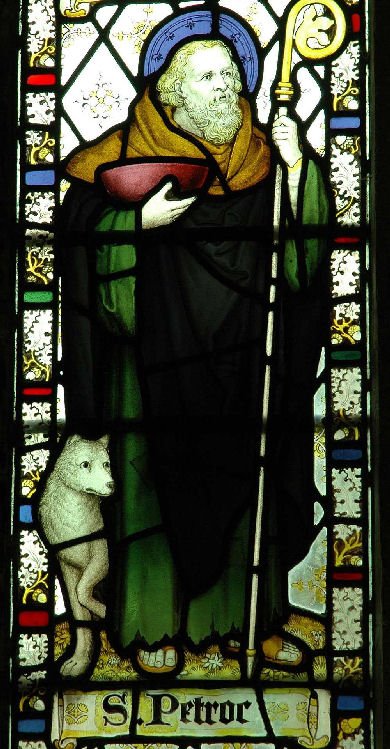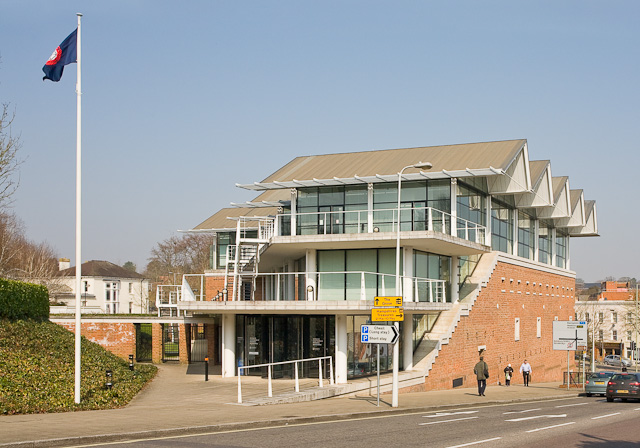|
St Thomas Church, Winchester
St Thomas Church (previously St Thomas & St Clement Church) is a disused Church of England parish church in Winchester, England. An earlier St Thomas Church (which itself replaced a church dedicated to St Petroc which fell into decay in the 14th century following the Black Death) was in St Thomas Street. It was demolished in 1845 and replaced by the present church, about 100m away in Southgate Street. Nikolaus Pevsner remarked that ''it is the most ambitious Victorian church in Winchester, and it is remarkable that it should be so early; for it is ‘archaeological’, i.e. no longer uninformed in its Gothic motifs and their handling''. The new church joined the parishes of St Thomas and St Clement and contained around 2,500 souls. The new church was consecrated on 16 April 1847 by the Bishop of Winchester. This church closed in 1969 and for a while housed the Hampshire Record Office. At that time it was listed Grade II and remains on the statutory List of Buildings of Specia ... [...More Info...] [...Related Items...] OR: [Wikipedia] [Google] [Baidu] |
England
England is a country that is part of the United Kingdom. It shares land borders with Wales to its west and Scotland to its north. The Irish Sea lies northwest and the Celtic Sea to the southwest. It is separated from continental Europe by the North Sea to the east and the English Channel to the south. The country covers five-eighths of the island of Great Britain, which lies in the North Atlantic, and includes over 100 smaller islands, such as the Isles of Scilly and the Isle of Wight. The area now called England was first inhabited by modern humans during the Upper Paleolithic period, but takes its name from the Angles, a Germanic tribe deriving its name from the Anglia peninsula, who settled during the 5th and 6th centuries. England became a unified state in the 10th century and has had a significant cultural and legal impact on the wider world since the Age of Discovery, which began during the 15th century. The English language, the Anglican Church, and Engli ... [...More Info...] [...Related Items...] OR: [Wikipedia] [Google] [Baidu] |
Church Of England
The Church of England (C of E) is the established Christian church in England and the mother church of the international Anglican Communion. It traces its history to the Christian church recorded as existing in the Roman province of Britain by the 3rd century and to the 6th-century Gregorian mission to Kent led by Augustine of Canterbury. The English church renounced papal authority in 1534 when Henry VIII failed to secure a papal annulment of his marriage to Catherine of Aragon. The English Reformation accelerated under Edward VI's regents, before a brief restoration of papal authority under Queen Mary I and King Philip. The Act of Supremacy 1558 renewed the breach, and the Elizabethan Settlement charted a course enabling the English church to describe itself as both Reformed and Catholic. In the earlier phase of the English Reformation there were both Roman Catholic martyrs and radical Protestant martyrs. The later phases saw the Penal Laws punish Ro ... [...More Info...] [...Related Items...] OR: [Wikipedia] [Google] [Baidu] |
Gothic Revival
Gothic Revival (also referred to as Victorian Gothic, neo-Gothic, or Gothick) is an architectural movement that began in the late 1740s in England. The movement gained momentum and expanded in the first half of the 19th century, as increasingly serious and learned admirers of the neo-Gothic styles sought to revive medieval Gothic architecture, intending to complement or even supersede the neoclassical styles prevalent at the time. Gothic Revival draws upon features of medieval examples, including decorative patterns, finials, lancet windows, and hood moulds. By the middle of the 19th century, Gothic had become the preeminent architectural style in the Western world, only to fall out of fashion in the 1880s and early 1890s. The Gothic Revival movement's roots are intertwined with philosophical movements associated with Catholicism and a re-awakening of high church or Anglo-Catholic belief concerned by the growth of religious nonconformism. Ultimately, the "Anglo-Catholicism" t ... [...More Info...] [...Related Items...] OR: [Wikipedia] [Google] [Baidu] |
The Buildings Of England
''The'' () is a grammatical article in English, denoting persons or things already mentioned, under discussion, implied or otherwise presumed familiar to listeners, readers, or speakers. It is the definite article in English. ''The'' is the most frequently used word in the English language; studies and analyses of texts have found it to account for seven percent of all printed English-language words. It is derived from gendered articles in Old English which combined in Middle English and now has a single form used with pronouns of any gender. The word can be used with both singular and plural nouns, and with a noun that starts with any letter. This is different from many other languages, which have different forms of the definite article for different genders or numbers. Pronunciation In most dialects, "the" is pronounced as (with the voiced dental fricative followed by a schwa) when followed by a consonant sound, and as (homophone of pronoun ''thee'') when followed by a v ... [...More Info...] [...Related Items...] OR: [Wikipedia] [Google] [Baidu] |
Winchester
Winchester is a City status in the United Kingdom, cathedral city in Hampshire, England. The city lies at the heart of the wider City of Winchester, a local government Districts of England, district, at the western end of the South Downs National Park, on the River Itchen, Hampshire, River Itchen. It is south-west of London and from Southampton, its nearest city. At the 2011 census, Winchester had a population of 45,184. The wider City of Winchester district, which includes towns such as New Alresford, Alresford and Bishop's Waltham, has a population of 116,595. Winchester is the county town of Hampshire and contains the head offices of Hampshire County Council. Winchester developed from the Roman Britain, Roman town of Venta Belgarum, which in turn developed from an Iron Age oppidum. Winchester was one of the most important cities in England until the Norman conquest of England, Norman conquest in the eleventh century. It has since become one of the most expensive and afflue ... [...More Info...] [...Related Items...] OR: [Wikipedia] [Google] [Baidu] |
St Petroc
Saint Petroc or Petrock ( lat-med, Petrocus; cy, Pedrog; french: link=no, Perreux; ) was a British prince and Christian saint. Probably born in South Wales, he primarily ministered to the Britons of Devon (Dewnans) and Cornwall (Kernow) then forming the kingdom of Dumnonia where he is associated with a monastery at Padstow, which is named after him (Pedroc-stowe, or 'Petrock's Place'). Padstow appears to have been his earliest major cult centre, but Bodmin became the major centre for his veneration when his relics were moved to the monastery there in the later ninth century. Bodmin monastery became one of the wealthiest Cornish foundations by the eleventh century. There is a second ancient dedication to him nearby at Little Petherick or "Saint Petroc Minor". In Devon ancient dedications total a probable seventeen (plus Timberscombe just over the border in Somerset), mostly coastal and including one within the old Roman walls of Exeter as well as the villages of Petrockstowe a ... [...More Info...] [...Related Items...] OR: [Wikipedia] [Google] [Baidu] |
Black Death
The Black Death (also known as the Pestilence, the Great Mortality or the Plague) was a bubonic plague pandemic occurring in Western Eurasia and North Africa from 1346 to 1353. It is the most fatal pandemic recorded in human history, causing the deaths of people, peaking in Europe from 1347 to 1351. Bubonic plague is caused by the bacterium ''Yersinia pestis'' spread by fleas, but it can also take a secondary form where it is spread by person-to-person contact via aerosols causing septicaemic or pneumonic plagues. The Black Death was the beginning of the second plague pandemic. The plague created religious, social and economic upheavals, with profound effects on the course of European history. The origin of the Black Death is disputed. The pandemic originated either in Central Asia or East Asia before spreading to Crimea with the Golden Horde army of Jani Beg as he was besieging the Genoese trading port of Kaffa in Crimea (1347). From Crimea, it was most likely carried ... [...More Info...] [...Related Items...] OR: [Wikipedia] [Google] [Baidu] |
Nikolaus Pevsner
Sir Nikolaus Bernhard Leon Pevsner (30 January 1902 – 18 August 1983) was a German-British art historian and architectural historian best known for his monumental 46-volume series of county-by-county guides, ''The Buildings of England'' (1951–74). Life Nikolaus Pevsner was born in Leipzig, Saxony, the son of Anna and her husband Hugo Pevsner, a Russian-Jewish fur merchant. He attended St. Thomas School, Leipzig, and went on to study at several universities, Munich, Berlin, and Frankfurt am Main, before being awarded a doctorate by Leipzig in 1924 for a thesis on the Baroque architecture of Leipzig. In 1923, he married Carola ("Lola") Kurlbaum, the daughter of distinguished Leipzig lawyer Alfred Kurlbaum. He worked as an assistant keeper at the Dresden Gallery between 1924 and 1928. He converted from Judaism to Lutheranism early in his life. During this period he became interested in establishing the supremacy of German modernist architecture after becoming aware of Le ... [...More Info...] [...Related Items...] OR: [Wikipedia] [Google] [Baidu] |
Hampshire Advertiser
The ''Hampshire Advertiser'' was a British local, broadsheet newspaper, based in Southampton, Hampshire. It ran from 1823 until 1940. Edward Langdon Oke (1775–1840), a corn merchant in the older part of the city (High Street), was credited with establishing the ''Hampshire Advertiser'' (previously the "Herald"). Oke, originally from Sherborne, was elected to the Town Council of Southampton and appointed Consul at Southampton for the Kingdom of Hanover by Prince Regent George IV George IV (George Augustus Frederick; 12 August 1762 – 26 June 1830) was King of the United Kingdom of Great Britain and Ireland and King of Hanover from the death of his father, King George III, on 29 January 1820, until his own death ten y ... in 1818. References Publications disestablished in 1900 1823 establishments in England Publications established in 1823 Newspapers published in Hampshire {{England-newspaper-stub ... [...More Info...] [...Related Items...] OR: [Wikipedia] [Google] [Baidu] |
Hampshire Record Office
Hampshire Archives and Local Studies holds the archives for the county of Hampshire. The archives are located in Sussex Street, Winchester, and are run by Hampshire County Council Hampshire County Council (HCC) is an English council that governs eleven of the thirteen districts geographically located within the ceremonial county of Hampshire. As one of twenty-four county councils in England, it acts as the upper tier of .... References Archives in Hampshire History of Hampshire County record offices in England {{library-struct-stub ... [...More Info...] [...Related Items...] OR: [Wikipedia] [Google] [Baidu] |
Listed Building
In the United Kingdom, a listed building or listed structure is one that has been placed on one of the four statutory lists maintained by Historic England in England, Historic Environment Scotland in Scotland, in Wales, and the Northern Ireland Environment Agency in Northern Ireland. The term has also been used in the Republic of Ireland, where buildings are protected under the Planning and Development Act 2000. The statutory term in Ireland is " protected structure". A listed building may not be demolished, extended, or altered without special permission from the local planning authority, which typically consults the relevant central government agency, particularly for significant alterations to the more notable listed buildings. In England and Wales, a national amenity society must be notified of any work to a listed building which involves any element of demolition. Exemption from secular listed building control is provided for some buildings in current use for worship, ... [...More Info...] [...Related Items...] OR: [Wikipedia] [Google] [Baidu] |



.png)





